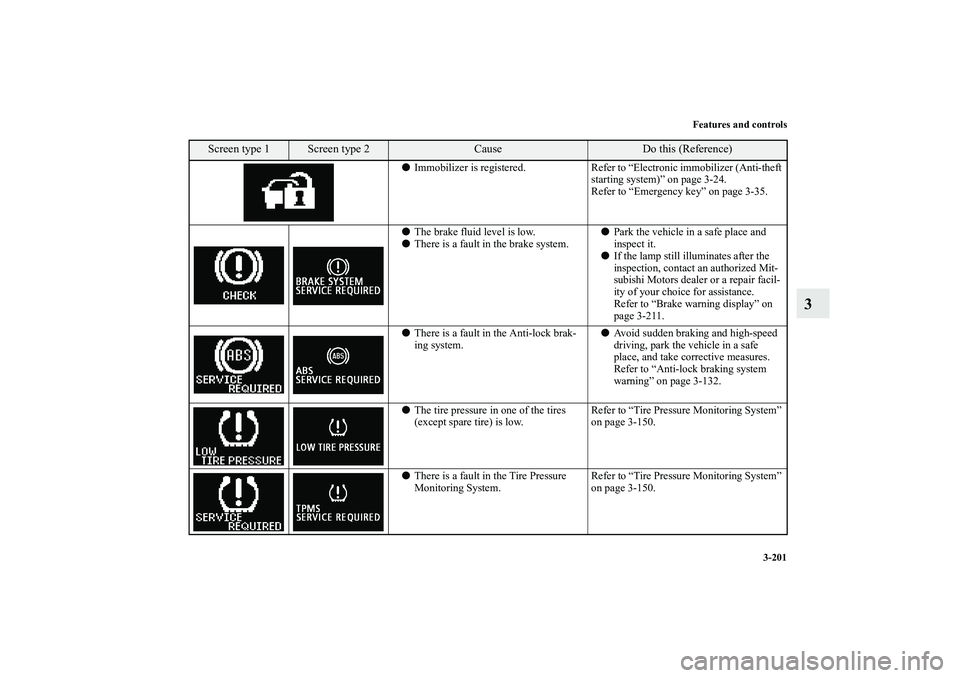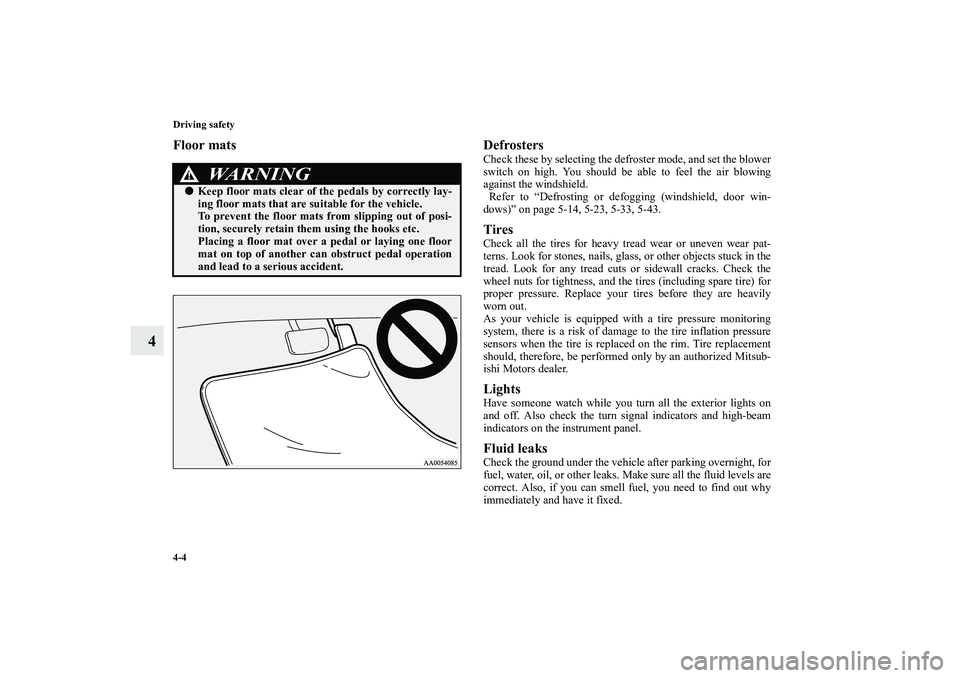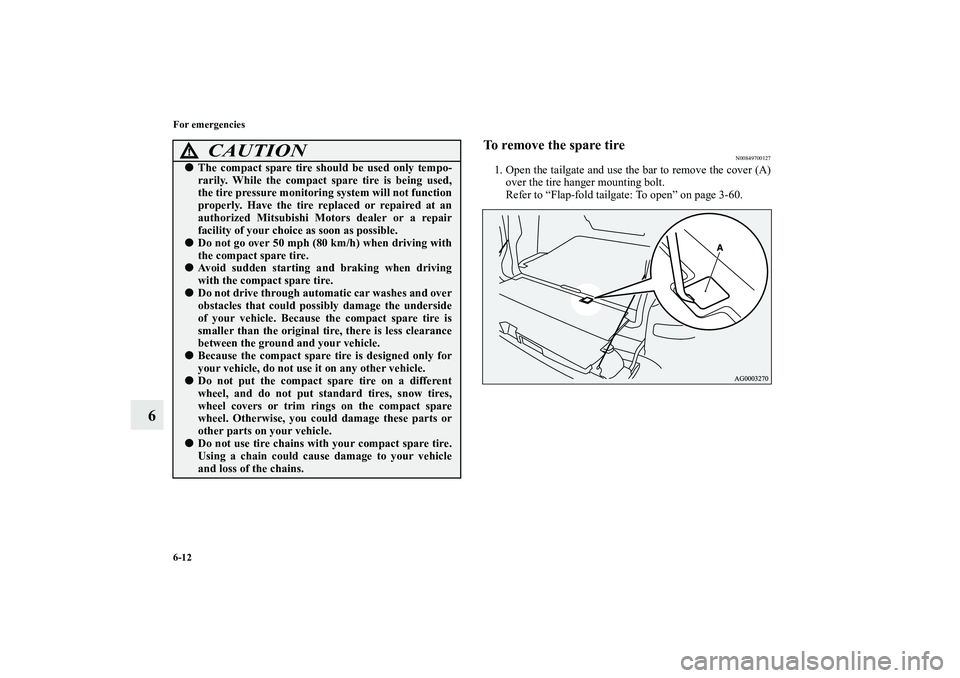Page 312 of 714

Features and controls
3-201
3
�Immobilizer is registered. Refer to “Electronic immobilizer (Anti-theft
starting system)” on page 3-24.
Refer to “Emergency key” on page 3-35.
�The brake fluid level is low.
�There is a fault in the brake system.�Park the vehicle in a safe place and
inspect it.
�If the lamp still illuminates after the
inspection, contact an authorized Mit-
subishi Motors dealer or a repair facil-
ity of your choice for assistance.
Refer to “Brake warning display” on
page 3-211.
�There is a fault in the Anti-lock brak-
ing system.�Avoid sudden braking and high-speed
driving, park the vehicle in a safe
place, and take corrective measures.
Refer to “Anti-lock braking system
warning” on page 3-132.
�The tire pressure in one of the tires
(except spare tire) is low.Refer to “Tire Pressure Monitoring System”
on page 3-150.
�There is a fault in the Tire Pressure
Monitoring System.Refer to “Tire Pressure Monitoring System”
on page 3-150.
Screen type 1
Screen type 2
Cause
Do this (Reference)
BK0115300US.book 201 ページ 2009年7月16日 木曜日 午前9時13分
Page 409 of 714

4-4 Driving safety
4
Floor mats Defrosters
Check these by selecting the defroster mode, and set the blower
switch on high. You should be able to feel the air blowing
against the windshield.
Refer to “Defrosting or defogging (windshield, door win-
dows)” on page 5-14, 5-23, 5-33, 5-43.TiresCheck all the tires for heavy tread wear or uneven wear pat-
terns. Look for stones, nails, glass, or other objects stuck in the
tread. Look for any tread cuts or sidewall cracks. Check the
wheel nuts for tightness, and the tires (including spare tire) for
proper pressure. Replace your tires before they are heavily
worn out.
As your vehicle is equipped with a tire pressure monitoring
system, there is a risk of damage to the tire inflation pressure
sensors when the tire is replaced on the rim. Tire replacement
should, therefore, be performed only by an authorized Mitsub-
ishi Motors dealer.LightsHave someone watch while you turn all the exterior lights on
and off. Also check the turn signal indicators and high-beam
indicators on the instrument panel.Fluid leaksCheck the ground under the vehicle after parking overnight, for
fuel, water, oil, or other leaks. Make sure all the fluid levels are
correct. Also, if you can smell fuel, you need to find out why
immediately and have it fixed.
WA R N I N G
!�
Keep floor mats clear of the pedals by correctly lay-
ing floor mats that are suitable for the vehicle.
To prevent the floor mats from slipping out of posi-
tion, securely retain them using the hooks etc.
Placing a floor mat over a pedal or laying one floor
mat on top of another can obstruct pedal operation
and lead to a serious accident.
BK0115300US.book 4 ページ 2009年7月16日 木曜日 午前9時13分
Page 580 of 714

For emergencies
6-11
6
NOTE�
The chocks shown in the illustration do not come with
your vehicle. It is recommended that you purchase chocks
or blocks and keep them in the vehicle for use if needed.
�
If chocks or blocks are not available, use stones or any
other objects that are large enough to hold the wheel in
position.
6. Get the jack, bar and wheel nut wrench ready.
(Refer to “Jack and tools” on page 6-7.)
Spare tire information
N00849600315
Compact spare tireThe compact spare tire is stowed below the luggage compart-
ment floor. It is designed to save space in the luggage compart-
ment. Its lighter weight makes it easier to use if a flat tire
occurs.
WA R N I N G
!�
Be sure to apply chocks or blocks to the correct tire
when jacking up the vehicle. If the vehicle moves
while jacked up, the jack could slip out of position,
leading to an accident.
WA R N I N G
!�
Tires, including spare tire, degrade over time with
age even when they are not being used. It is recom-
mended that tires over 6 years generally be replaced
even if damage is not obvious.CAUTION
!�
While the compact spare tire is stowed, the inflation
pressure should be checked at least once a month to
assure that it remains at the recommended inflation
pressure. See the tire and loading information plac-
ard attached to the driver’s door sill. Refer to “Tire
and loading information placard” on page 9-4.
�
Driving with an improperly inflated tire can cause
an accident. If you have no choice but to drive with
an under-inflated tire, keep your speed down and
avoid sudden steering or braking, if possible. Inflate
the tire to the correct pressure as soon as possible.
Refer to “Tire inflation pressures” on page 7-27.
BK0115300US.book 11 ページ 2009年7月16日 木曜日 午前9時13分
Page 581 of 714

6-12 For emergencies
6
To remove the spare tire
N00849700127
1. Open the tailgate and use the bar to remove the cover (A)
over the tire hanger mounting bolt.
Refer to “Flap-fold tailgate: To open” on page 3-60.
�
The compact spare tire should be used only tempo-
rarily. While the compact spare tire is being used,
the tire pressure monitoring system will not function
properly. Have the tire replaced or repaired at an
authorized Mitsubishi Motors dealer or a repair
facility of your choice as soon as possible.
�
Do not go over 50 mph (80 km/h) when driving with
the compact spare tire.
�
Avoid sudden starting and braking when driving
with the compact spare tire.
�
Do not drive through automatic car washes and over
obstacles that could possibly damage the underside
of your vehicle. Because the compact spare tire is
smaller than the original tire, there is less clearance
between the ground and your vehicle.
�
Because the compact spare tire is designed only for
your vehicle, do not use it on any other vehicle.
�
Do not put the compact spare tire on a different
wheel, and do not put standard tires, snow tires,
wheel covers or trim rings on the compact spare
wheel. Otherwise, you could damage these parts or
other parts on your vehicle.
�
Do not use tire chains with your compact spare tire.
Using a chain could cause damage to your vehicle
and loss of the chains.CAUTION
!
BK0115300US.book 12 ページ 2009年7月16日 木曜日 午前9時13分
Page 582 of 714
For emergencies
6-13
6
2. With the wheel nut wrench, loosen the tire hanger mount-
ing bolt by turning it counterclockwise.
3. Raise the lower gate until it clicks and locks.
Refer to “Flap-fold tailgate: To open” on page 3-60.4. Lift up the section of the tire hanger (B) that is marked
with the arrow in the illustration and remove it from the
hook (C). Then lower it and remove the tire.
CAUTION
!�
While checking the tire hanger, carefully loosen the
tire hanger mounting bolt. Loosening it too much
could pull out the hook and cause the compact spare
tire to drop.
CAUTION
!�
When hooking or unhooking the tire hanger, be sure
to hold the tire hanger firmly to prevent it from
dropping on your foot.
BK0115300US.book 13 ページ 2009年7月16日 木曜日 午前9時13分
Page 583 of 714
6-14 For emergencies
6
To install
N00860500027
1. Place the tire on the center of the tire hanger, with the
wheel surface facing upwards.2. Lift up the tire hanger (A) and hook it on the hook (B).
CAUTION
!�
Storing the tire with the wheel surface facing down
may damage the wheel or tire hanger. If you find
any damage on a spare tire, do not use the tire and
contact an authorized Mitsubishi Motors dealer or a
repair facility of your choice.
CAUTION
!�
Make sure you hook the tire hanger in the proper
position. If the tire hanger is not hooked properly,
the hook could damage the vehicle body or the tire
could fall off the vehicle while driving, causing an
accident.
BK0115300US.book 14 ページ 2009年7月16日 木曜日 午前9時13分
Page 584 of 714
For emergencies
6-15
6
3. Open the lower gate.
Refer to “Flap-fold tailgate: To open” on page 3-60.
4. With the wheel nut wrench, firmly tighten the tire hanger
mounting bolt by turning it clockwise.
5. Install the cover over the tire hanger mounting bolt.
To change a tire
N00849800418
1. On vehicles with wheel covers, first remove the covers
(refer to “Wheel covers” on page 6-23). Then, loosen the
wheel nuts with the wheel nut wrench. Do not remove the
wheel nuts yet.
CAUTION
!�
Confirm that the tire hanger is firmly secured after
storing the spare tire. If the tire hanger is not
secured, it could drop out while driving, causing an
accident.
�
When hooking or unhooking the tire hanger, be sure
to hold the tire hanger firmly to prevent it from
dropping on your foot.
BK0115300US.book 15 ページ 2009年7月16日 木曜日 午前9時13分
Page 585 of 714
6-16 For emergencies
6
2. Place the jack under one of the jacking points (A) shown
in the illustration. Use the jacking point closest to the tire
you wish to change.
NOTE�
Put the spare wheel under the vehicle body near the jack.
This makes it safer if the jack slips out of position.
WA R N I N G
!�
Set the jack only at the positions shown here. If the
jack is set at a wrong position, it could dent your
vehicle or the jack might fall over and cause per-
sonal injury.
�
Do not use the jack on a tilted or soft surface.
Otherwise, the jack might slip and cause personal
injury. Always use the jack on a flat, hard surface.
Before setting the jack, make sure there are no sand
or pebbles under the jack base.
BK0115300US.book 16 ページ 2009年7月16日 木曜日 午前9時13分